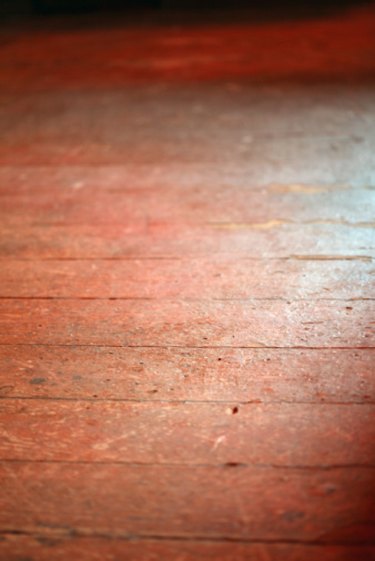Things You'll Need
Latex wood floor filler
Trowel
Bucket
Rubber grouting float
Flooring drum sander
80- and 100-grit sandpaper
Vacuum
Flooring edger
80- and 100-grit sanding discs
Pull scraper

As a hardwood floor ages, gaps often develop between the boards as they expand and contract. Eventually, the gaps become obvious enough to detract from the appearance of the floor, and it's time for a refinish. Filling all the cracks individually with a putty knife prior to sanding is usually a big job, but you can make it considerably easier by spreading filler over the entire floor with a float. When you sand the floor, the machine will remove excess filler from the surface of the wood and leave it only in the gaps.
Step 1
Trowel about half the contents of a gallon container of latex wood filler into a bucket. Add water and stir the mixture until it is pourable but still stiff, somewhat like honey.
Video of the Day
Step 2
Pour the filler onto the floor and spread it with a rubber grouting float, applying it directly over the old finish. Use wide, sweeping motions to spread the filler over the surface and work it into all gaps and cracks. Spread unthinned filler on gaps or holes that are too wide for the thinned mixture to cover. Let the filler dry for three or four hours.
Step 3
Place an 80-grit sanding belt on a drum sander. Move the sander to the center of the room then position it so it faces a corner. Turn it on and sand the floor diagonally across the grain by moving the sander back and forth between the center of the floor and the wall. When you have sanded half of the floor in this way, turn the sander around and do the other half of the floor.
Step 4
Vacuum the sanding dust, then turn the drum sander so it faces parallel to the direction of the floorboards. Sand the floor once more in this direction to remove the cross-grain scratch marks from the last pass.
Step 5
Fit an 80-grit disc on a flooring edger, which is a heavy-duty disc sander, and sand the edges of the floor that you couldn't reach with the drum sander. Move the edger back and forth or in a circular motion, bringing it as close as possible to the baseboards and into the corners. Use a pull scraper to remove filler and finish from areas you can't reach with the edger.
Step 6
Clean up the sanding dust with a vacuum and sand the floor once again with the drum sander and edger. Use 100-grit paper to remove scratches left by the coarser paper and smooth the floor for finishing.
Tip
Latex wood filler comes in a variety of colors. Choose the one that best matches the color of your floorboards.
If the floor has only a few gaps, it may be easier to fill them individually with a putty knife.
Warning
If you have a parquet floor or one consisting of engineered boards with a veneer, use a flooring orbital sander instead of a drum sander and edger. The drum sander will make cross-grain scratches on parquet and may wear through the veneer of engineered flooring.
Video of the Day